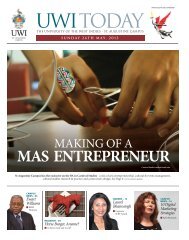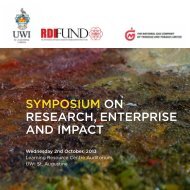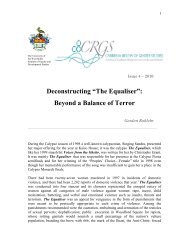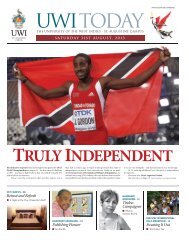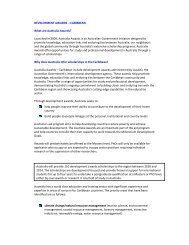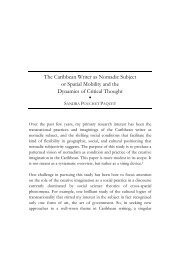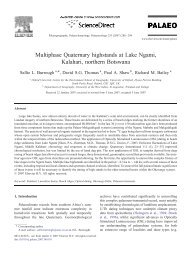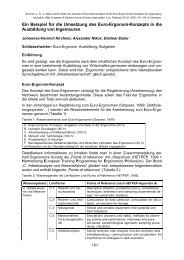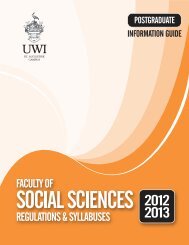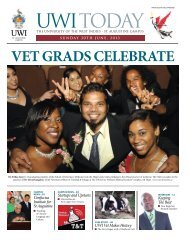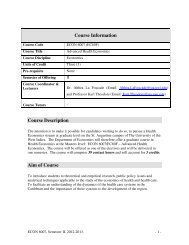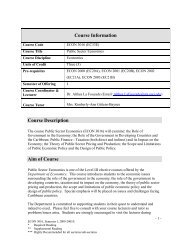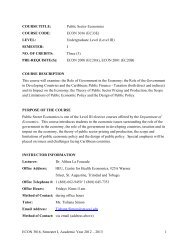Faculty of Humanities and Education (Postgraduate) - The University ...
Faculty of Humanities and Education (Postgraduate) - The University ...
Faculty of Humanities and Education (Postgraduate) - The University ...
Create successful ePaper yourself
Turn your PDF publications into a flip-book with our unique Google optimized e-Paper software.
POSTGRADUATE REGULATIONS & SYLLABUSES 2012 - 2013<br />
THE FACULTY OF HUMANITIES & EDUCATION<br />
Recommended reading<br />
Bailey, W., Branche, C., McGarrity, G., Stuart, S. (1998). Family <strong>and</strong> the<br />
quality <strong>of</strong> gender relations in the Caribbean. Mona: Institute<br />
for Social <strong>and</strong> Economic Research. (ISBN: 9764000568)<br />
Chevannes, B. (1999). What we sow <strong>and</strong> what we reap: problems<br />
in the cultivation <strong>of</strong> male identity in Jamaica. Kingston: Grace<br />
Kennedy Foundation. (ISBN: 9768041129).<br />
Cooper, S. W., Kellogg, N. D., Giardino, A. P. (2006). Child<br />
sexual exploitation quick reference: for health care,<br />
social service, <strong>and</strong> law enforcement pr<strong>of</strong>essionals.<br />
G. W. Medical Publishing. (ISBN: 187806021X)<br />
Feldman, S. S., Rosenthal, D. A. eds. (2002). Talking sexuality:<br />
parent-adolescent communication. New directions for child<br />
<strong>and</strong> adolescent development. San Francisco: Jossey-Bass.<br />
(ISBN: 0787963259)<br />
Halstead, J., Halstead M., & Reiss, M. J. (2002). Sex education:<br />
Principles, policy <strong>and</strong> practice. London: Routledge-Falmer.<br />
(ISBN: 0415232562)<br />
Holmes, K. K., Sparling, P. F., Mardh P.A., Lemon, S. M., Stamm<br />
W. E., Piot P., Wasserheit J. N. eds. (2006) Sexually<br />
transmitted diseases. McGraw-Hill (ISBN: 007029688X)<br />
Leo-Rhynie, E., Bailey, B., Barrow, C. eds. (1997). Gender: A<br />
Caribbeam multi-disciplinary perspective. Kingston: Ian<br />
R<strong>and</strong>le.<br />
Libby, R. (2006) <strong>The</strong> naked truth about sex: A guide to intelligent<br />
sexual choices for teenagers <strong>and</strong> twentysomethings.<br />
California: Freedom Press. (ISBN: 1893910385)<br />
McAnulty, R. D., Burnette, M. M. (2003). Exploring human sexuality:<br />
Making healthy decisions (2nd ed.). Boston: Allyn & Bacon.<br />
(ISBN: 020538059X)<br />
Measor, L. (2000). Young people’s views on sex education:<br />
<strong>Education</strong>, attitudes <strong>and</strong> behaviour. London: Routledge-<br />
Falmer. (ISBN: 0750708948)<br />
Mohammed, P., Shepherd, C. (2002). Gender in Caribbean<br />
development. Mona, Jamaica: <strong>University</strong> <strong>of</strong> the West Indies<br />
Press. (ISBN: 9768125551)<br />
Newburn, T., Stanko, E. A. eds. (1994). Just boys doing business?<br />
Men, masculinities & crime. London: Routledge. (ISBN:<br />
0415903201)<br />
Spong, J. S. (1990). Living in sin? A bishop rethinks human sexuality.<br />
San Francisco: Harper & Row. (ISBN: 0 06 067505 5)<br />
Thorne, B. (1993). Gender play: Girls <strong>and</strong> boys in school.<br />
Buckingham: Open <strong>University</strong> Press. (ISBN: 0 355 19123 1)<br />
Websites<br />
www.who.org<br />
www.unaids.org<br />
www.caricom.org<br />
www.unesco.org<br />
www.unfpa.org<br />
www.unicef.org<br />
www.undp.org<br />
www.nlm.gov<br />
www.cdc.gov<br />
Journals<br />
Social Science <strong>and</strong> Medicine<br />
<strong>The</strong> Lancet<br />
<strong>The</strong> New Engl<strong>and</strong> Journal <strong>of</strong> Medicine<br />
Morbidity <strong>and</strong> Mortality Weekly Report<br />
6.2 HEPR 6002 - Risk in the Context <strong>of</strong> Modern Social Lives<br />
(4 credits)<br />
Course Overview<br />
Human behaviours are embedded in social relations <strong>and</strong> cultural<br />
forms. In early health promotion programmes, too little attention<br />
was paid to the role this ëembeddedness’plays in entrenching risk<br />
<strong>and</strong> generating resistance to protective change. <strong>The</strong> present course<br />
is built on assumptions that knowledge is socially constructed <strong>and</strong><br />
that behaviours (safe <strong>and</strong> otherwise) are socially embedded. In<br />
order to deepen participants’ underst<strong>and</strong>ing <strong>of</strong> the influence <strong>of</strong><br />
embeddedness, this course will focus on the role <strong>of</strong> relationships,<br />
relationship dynamics <strong>and</strong> networks in health promotion. <strong>The</strong><br />
focus will also be on analysing, <strong>and</strong> underst<strong>and</strong>ing risk as it relates<br />
to these relationships <strong>and</strong> networks, <strong>and</strong> on the impact <strong>of</strong> these<br />
risks on health <strong>and</strong> well-being.<br />
OBJECTIVES<br />
At the end <strong>of</strong> the course, participants will be able to:<br />
• Demonstrate a clear underst<strong>and</strong>ing <strong>of</strong> social <strong>and</strong> cultural<br />
influences on behaviour <strong>and</strong> resistance to change<br />
• Demonstrate underst<strong>and</strong>ing <strong>and</strong> insight into how cultural <strong>and</strong><br />
social embeddedness can assist in transforming behaviour on<br />
a sustainable basis<br />
• Demonstrate an underst<strong>and</strong>ing <strong>of</strong> the relationship between<br />
social systems <strong>and</strong> the promotion <strong>and</strong> entrenchment <strong>of</strong><br />
dangerous <strong>and</strong> unhealthy patterns <strong>and</strong> practices<br />
• Analyse<strong>and</strong>critiquethesocialnetworksthathealthpromotion<br />
workers will need to mobilize <strong>and</strong> work closely with<br />
• Use knowledge <strong>of</strong> social diversity to work with, <strong>and</strong> advocate<br />
for, people from diverse backgrounds<br />
• Critically analyse health issues in their social context using the<br />
concept <strong>of</strong> ërisk’ as an analytical tool<br />
• Critically analyse health issues in a framework <strong>of</strong> human rights<br />
<strong>and</strong> social justice, <strong>and</strong> to design health promotion strategies<br />
accordingly<br />
CONTENT<br />
• Adolescence, school-ground cultures, peer groups, <strong>and</strong> gangs<br />
• Relationships in diverse cultures<br />
• Strengthening families <strong>and</strong> family life<br />
• Gender <strong>and</strong> power in relationships<br />
• Gender <strong>and</strong> violence<br />
• Sexual <strong>and</strong> gender diversity<br />
• Ageing<br />
• Disability<br />
• Mass media <strong>and</strong> communication<br />
• What is risk?<br />
• Stigmatized conditions, marginalized populations, <strong>and</strong><br />
unpopular issues<br />
• Networks <strong>and</strong> socially embedded risks<br />
• Protective networks, the potential <strong>of</strong> parents, teachers, &<br />
peers<br />
• Bullying, violence, harassment, <strong>and</strong> hate crimes<br />
• Domestic violence <strong>and</strong> sexual assault<br />
• High-risk settings <strong>and</strong> special populations – underst<strong>and</strong>ing<br />
drug use, gay men <strong>and</strong> women, sex workers, <strong>and</strong> so on<br />
• Drugs, alcohol, tobacco<br />
• Mental health <strong>and</strong> suicide<br />
• Poverty <strong>and</strong> power<br />
109



